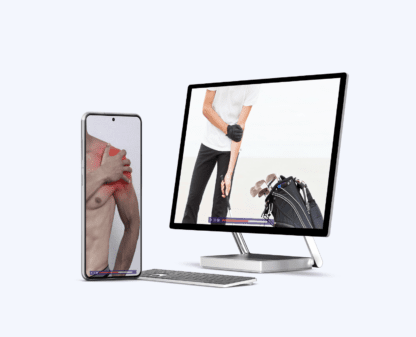Arthroscopic Bankart versus open Latarjet for traumatic anteroinferior instability

Introduction
Traumatic shoulder dislocations occur often in a variety of sports and sometimes conservative management fails. Instability may persist and interfere with daily activities, requiring operative treatment. Two procedures are commonly used: the arthroscopic Bankart versus the open Latarjet. The Bankart procedure is mostly used and here the torn labrum and inferior glenohumeral ligament are reattached to the glenoid rim. The Latarjet involves a transfer of the coracoid process and tendons of the short head of the biceps and coracobrachialis to the anterior glenoid. Studies report on a high dislocation rate after a Bankart procedure, but this was not confirmed by randomized studies up till now. Therefore this study aimed to compare Bankart and Latarjet for recurrent instability.
Methods
This multicentre randomized controlled trial included males between 16-25 with anteroinferior shoulder instability after a traumatic dislocation. They were randomly assigned to Bankart or Latarjet procedures. Prior to surgery, patients were assessed clinically using the Jobe relocation test, also known as the apprehension-relocation test.
Hyperlaxity was defined as external rotation above 90° and/or the Gagey hyperabduction test above 100°.
After the surgical procedures, patients in both groups had to wear a sling for 3 weeks. Hereafter they started physiotherapy consisting of exercises to increase their range of motion and progressed to active exercises during the first 6 weeks. Activities requiring maximal force were restricted for 3 months and patients couldn’t participate in contact sports for 6 months.
The primary outcome of this study was the recurrence of shoulder dislocation at 2 years. Secondary outcomes were assessed at 3 and 6 months and at 1 and 2 years postoperatively.
Results
Bankart and Latarjet for recurrent instability were compared at 2 years in 91 patients. The results reveal that in the Bankart group, 10 patients redislocated their shoulder with only 1 redislocation seen in the Latarjet group. This difference in redislocations was statistically significant. Three patients initially treated with the Bankart procedure were reoperated using the Latarjet surgery and crossed over to the other study arm.

Questions and thoughts
Looking at the hazard ratios for early dislocation in the Bankart group reveals that the redislocations were not influenced by confounding factors such as hyperlaxity, involvement in contact sports, and/or significant humeral and glenoid defects.
The secondary outcomes revealed no differences between the Bankart or Latarjet surgery, despite the significant difference in redislocations seen between both groups. The reason therefore may be that these questionnaires are not responsive enough to capture difficulties when performing high-demand activities. When looking at the return to sports rate, a higher percentage of patients returned to a competitive level of sports in the Latarjet group, thereby confirming this statement. The fact that the findings were analyzed using an intention-to-treat approach caused 3 patients originally allocated to the Bankart group to be analyzed in the Latarjet group, which may have caused a small compensation for the otherwise potentially worse outcome to be expected in the Bankart group.
A relevant question to this study would be whether patients continued physiotherapy rehab after study procedures were finished. A difference between post-operative rehab not measured/quantified here, could have influenced the findings. The methods section specifies that both groups received an invitation to physiotherapy management but it was not specified if the sessions were equally attended by participants in both groups. During the first 6 weeks, it was specified that the exercises targeted ROM gradually, with individual progression to active exercises. However, the frequency and intensity of the physiotherapy sessions were not specified. I could imagine that after these 6 weeks some patients at least continued physiotherapy independent of the study procedures. So here we are left a bit in the dark.
Talk nerdy to me
The surgeons held a consensus meeting discussing the procedures prior to trial commencement. This was to ascertain the consistency in the procedures. Sample size was calculated and required 122 patients to be recruited, to ascertain 43 analyzed subjects in each group. The flow chart revealed that the recruitment had been successful as 48 and 43 subjects were analyzed in the Bankart and Latarjet groups respectively.
Patients were allowed to crossover in case recurrent instability was seen. However, all analyses were performed using an intention-to-treat approach. Another positive finding was that no complications occurred in either group, so the surgical approaches were safe.
No report of blinding of assessors was made, however, the primary outcome is a hard one (an objective redislocation), therefore no real bias issues are to be expected.
Take home messages
This study examining Bankart and Latarjet for recurrent instability found that patients receiving Bankart surgery were more susceptible to redislocation in the first 2 years. This study however included only young active males aged 16-25 years, and may therefore not be widely generalizable. No concrete details on the postoperative physiotherapy rehab were given. With these findings in mind, it would be necessary to follow patients post-Bankart more closely and to give them more intensive rehab, to try to overcome this difference in redislocations at 2 years.
Reference
WATCH TWO 100% FREE WEBINARS ON SHOULDER PAIN AND ULNA-SIDE WRIST PAIN
Improve your Clinical Reasoning for Exercise Prescription in the Active Person with Shoulder pain with Andrew Cuff and Navigate Clinical Diagnosis & Management featuring a Case Study of Golfer with Thomas Mitchell



